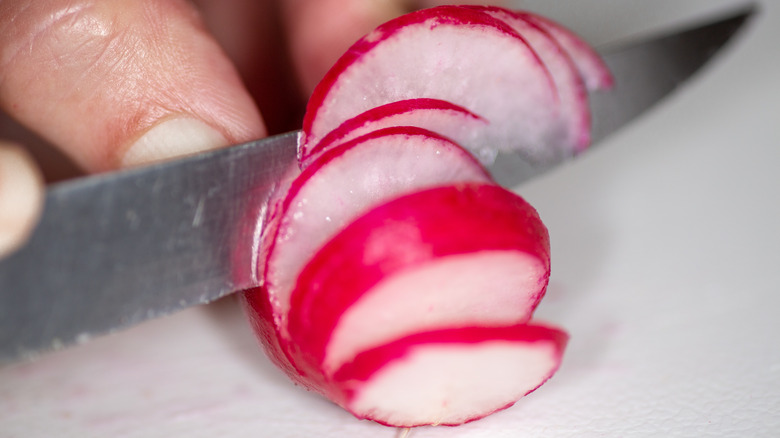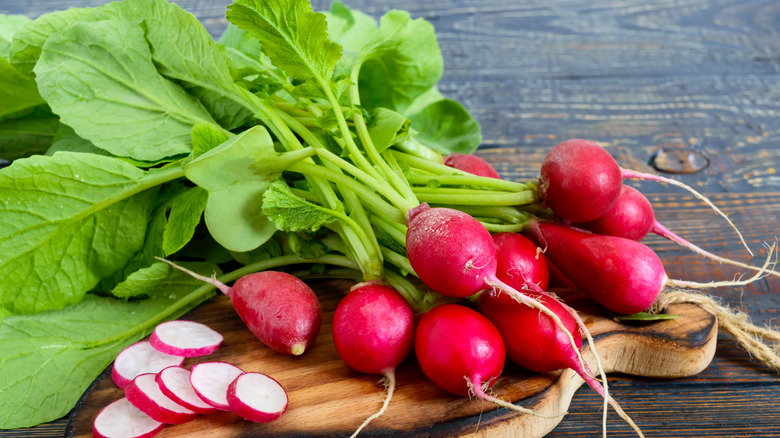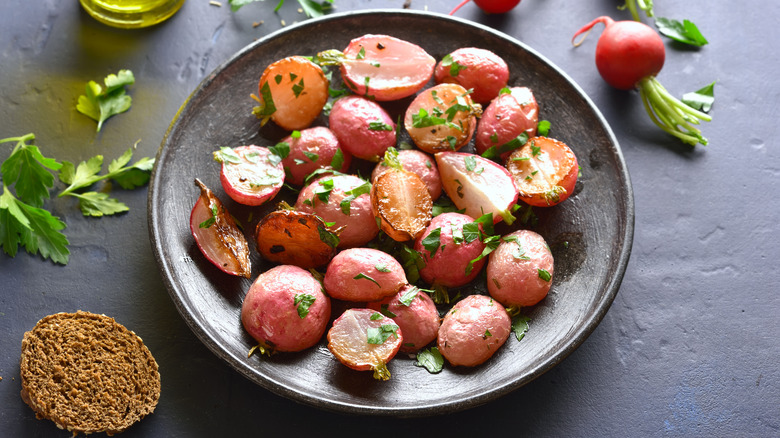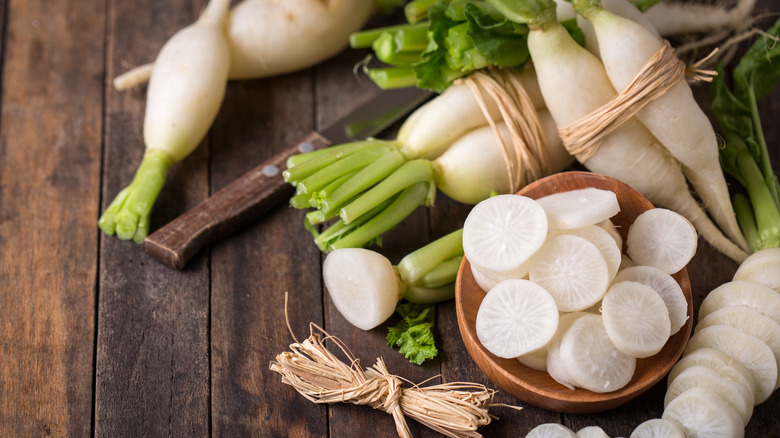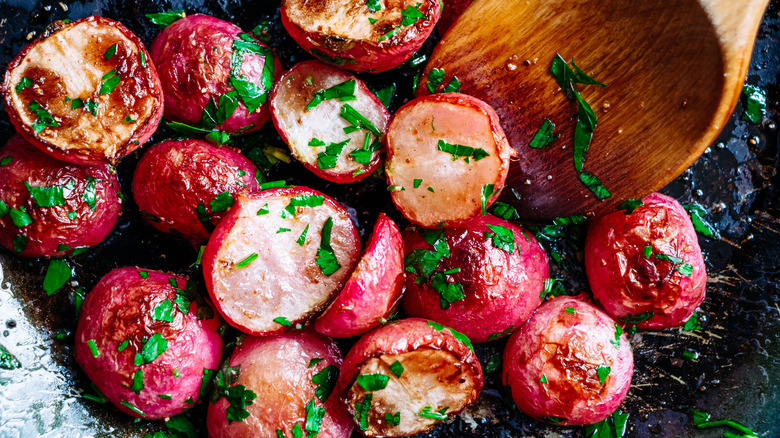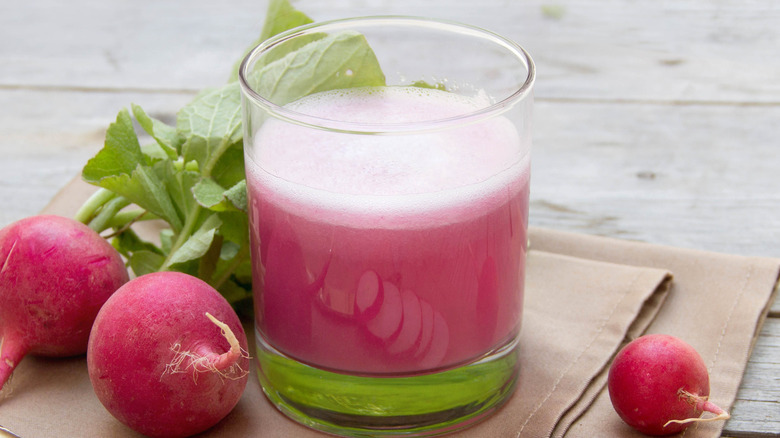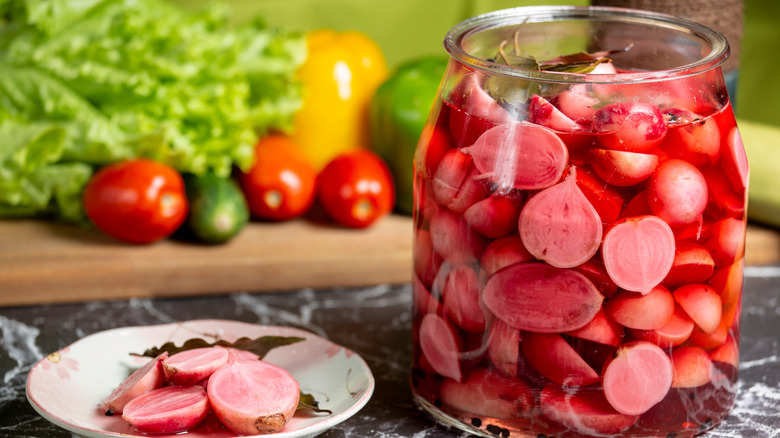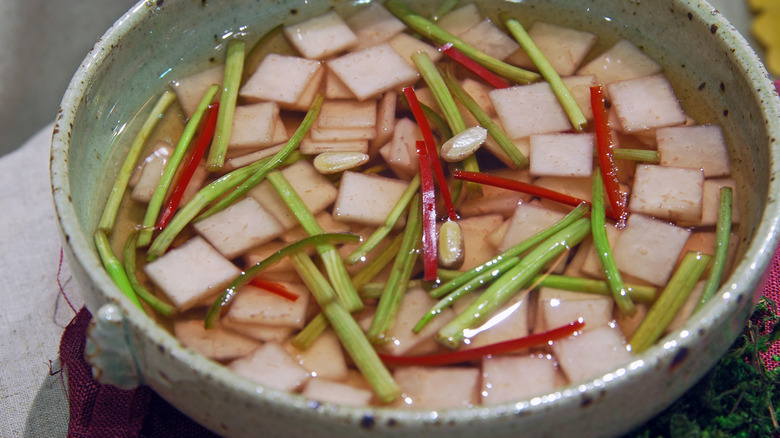15 Radish Hacks You Should Try
Radishes are so fabulous that they even have their own Mexican festival — the Night of the Radishes — which showcases large sculptures carved out of the root vegetable (via NPR). It makes sense that they're connected with hearty dishes, as a study published in Plant Foods for Human Nutrition in 2009 revealed that an enzyme in radishes is responsible for breaking down carbs for easier digestion.
There are many varieties of radishes, each with its own delectable taste. Table radishes are your most common, often red or pink and sometimes even white or purple. Meanwhile, there's also the large white daikon which is less peppery, whereas the Spanish black radish (which is actually white inside) has a more intense flavor. Another variety is half red and half white, aka Fire and Ice, and there's even one that looks like a small watermelon (via Gardening Know How).
Radishes are not only an afterthought to simply add to salads for some color, crunch, and heat — although this is a great way to eat them. It's time to revolutionize your radish game with our selection of easy hacks.
1. Make French-inspired radish butter
Inspired by a French recipe book, a Reddit user divulged a sublime way to eat radishes that is so simple, yet tastes far more exciting. Culinary combinations allow you to match two ingredients and create an extraordinary flavor without much effort at all. With this hack, all you need are some radishes, a pat or two of butter, a baguette, plus some sea salt.
Slice your radishes and place them on top of your buttered bread, then add a good sprinkle of salt. Voilà! You might find that breakfast radishes work best for this snack because the taste is milder and they're not as peppery. If you want to add some color, try chopping up the radish greens too and adding them to the butter. This will give your open-faced sandwich a bit of a kick to effortlessly contrast with the sweet radishes, soft bread, and salty butter.
2. Try French-inspired butter-dipped radishes
Continue your French-themed radish, butter, and salt combo with an incredibly attractive dish that you can serve for breakfast, lunch, as an appetizer, and even as a simple snack or hors d'oeuvre at a party. Spread some butter over French breakfast radishes and finish them off with a sprinkling of sea salt over the top. The sweet crunchy radishes are perfectly enhanced by the creamy butter and salty crystals.
If you don't feel like spreading hard butter over each radish, there's an easy shortcut. Wash and trim a few bunches of radishes at the root end, so that they're still pointed along the bottom. Melt a stick of butter in the microwave and mix it up so that it's creamy looking rather than fully melted and transparent. If you over-melt the butter, let it cool down and thicken. Dip each radish tip into the butter and leave it to set on a baking sheet lined with wax paper. If the butter starts to harden as you're dipping, give it a blast in the microwave for a few seconds. Pop the tray into the refrigerator until the butter hardens and serve the tasty radishes with sea salt.
3. Grow your own radishes
There's something so glorious about growing your own vegetables and the best part is you don't even need a big garden. A windowsill veggie garden is easy to make, and if you plant radishes, you should be able to grow a plentiful supply in less than a month. What really appeals about growing your own radishes is that they really only need a little TLC and you don't need any complex gardening knowledge. All you need are a few tips to get your gardening green thumbs going and some red radishes growing.
According to GardeningEtc, you can grow radishes between other plants and they are successful in container pots as well. The outlet notes that you should plant the seeds from spring through summer, choosing one or a few different varieties and planting them in accordance. Be sure to water them well and give them plenty of space. It's best to hold off on planting endless rows of radishes and let the first batch sprout and grow first. Radishes love soil that's full of moisture and taste the best when they're not too big — about one inch across — otherwise they take on a woody texture. Remember that you can cut off the leaves and use them in recipes before the root is ready to harvest.
4. Craft radish star garnishes
While life may be too short to stuff a mushroom, as famously stated by British author Shirley Conran, there's something wonderfully relaxing and satisfying about making radish stars. You may have heard of radish flowers and have no doubt come across a radish garnish or two in a dish. A paring knife and some know-how can easily set you up with some snazzy radish stars thanks to a vegetable carving tip by Mamiverse.
Start by trimming off both ends so that they sit flat. Place the radish down on your cutting board and use a paring knife to begin your crafting. Create a V-shape that ends close to the bottom of the root by cutting from the top at opposite angles. Make sure the cuts at the end of the V point meet so that you can remove the portion of radish that's been carved. Start the first cut from the tip and slice the second close by. Repeat this process around the radish and you'll start to see a star shape appear. We guarantee it's bright enough to light up any dinner plate as an edible garnish.
5. Roast radish flower petals
While radish flowers and stars are undeniably beautiful, there's something delicately elegant about radish flower petals. Lifehacker shares a tip to create a unique, light, and crispy snack or garnish that wows in terms of taste and style. Thin slices of radish are roasted so that they brown at the edges and curl up, retaining their blush coloring which makes them look just like petals. Use watermelon radishes for an attractive floral display, although any red radishes will do in a pinch.
The key is to cut really thin and even slices — a mandoline would be ideal for this task. Wash, dry, and coat them in olive oil before laying the slices on a lined baking tray, without overlap. Sprinkle a little salt on top and roast the radish petals at 375 F, keeping an eye on the browning to determine when they're ready. You'll be stunned by the results, and you'll no doubt enjoy the crispy, salty, and slightly peppery taste. Enjoy them solo, serve them on toast, or add them to a number of dishes.
6. Use sprouted radish seeds in dishes
There's more to a radish than its ruby-red root (as appetizing as this part is when sliced and thrown into a salad). You may be surprised to know that you can also eat radish seeds. If you're looking for some easy ways to start incorporating the seeds into your diet, try toasting them (via Everything Radish). Then add them to dishes or highlight the taste by sprinkling them on top of a salad. You can even add them to sandwiches or throw some into a smoothie. The crunch and subtly spicy flavor of radish seeds give them character and make them a great ingredient staple for so many recipes.
In fact, not only are radish seeds tasty, but they're also nutritious and packed with vitamins. They contain plenty of fiber and potassium and according to Health Benefits Times, they have been used in Chinese medicine since the 19th century. Some of their purported benefits include lowering blood pressure and blood sugar, as well as diuretic properties that can help eliminate kidney stones. The seeds are good for the skin and bones, and they are renowned for helping with digestion too.
7. Pickle radish pods
Radish seeds come in edible green pods, which boast various nutritious properties including a notable antioxidant content (via Nuturemite). The pods are soft but still have a satisfying bite, and according to Smithsonian Magazine, taste somewhat milder than a radish root. They can be eaten raw or cooked, such as mixed into salads or stir-fries as is common in Asia. They can also be pureed into a spread to layer on your sandwich bread.
You may have tasted pickled onions but have you ever thought of making pickled radish pods? If you grow your own radishes then you can easily create this tangy, sweet, and spicy snack. One Green Planet suggests picking the pods when they're still green before they start to seed. A combination of water, rice and white vinegar, sugar, and salt will transform these green pods into crunchy pickled delights. Enjoy them as a topping for tacos, sandwiches, and salads, or simply eat them straight from the jar.
8. Save your radishes by using the greens
Along with radish roots, pods, and seeds, you can also use the leaves. This doesn't just come down to a culinary decision either. Removing the leaves helps radishes last longer, so it's worthwhile to do so as soon as you get your hands on a bunch. The leaves take water away from the roots which can lead to soggy mulchy greens and dry unappetizing roots (via Lifehacker). Eliminate the issue by knowing how to properly store and use the leaves.
Start by removing the greens, rinsing them thoroughly, and drying them completely. Store them in a sealed bag with a sheet of paper towel inside and be sure to use them within a few days. You can use raw radish tops raw in salads, but they taste best if the greens are young. Otherwise, they may have a bitter flavor and a tougher less appealing texture.
You can also fry or braise the greens, but an even simpler recipe is to make a radish top pesto. It's easy to make using a food processor, and you'll only need garlic, olive oil, pine nuts, Parmesan, lemon juice, and seasoning. Pulse the ingredients together with roughly chopped radish greens and you've got yourself a fresh batch of pesto.
9. Mellow the heat of peppery radishes
Have you ever bitten into a radish and quickly reached for a glass of water to cool down your taste buds? Some radishes are hotter than others, and they're particularly peppery if eaten raw. While you can cook radishes to subdue the spice, if you enjoy them fresh and raw but with a little less heat, then you'll be pleased to know there's a way to mellow them out.
Spoon University instructs home cooks to start by rinsing the radishes, then topping and tailing them. Cut a square grid design into the root by cutting about three-quarters deep into the radish a couple of times, creating parallel lines. Turn your radish and create more lines, so that these cut across the first ones at right angles. Plunge the radishes into ice water and leave them in the refrigerator for at least 45 minutes. You can eat them straight away or dry them and enjoy a healthy raw radish snack with the heat turned down, whenever you like.
10. Cook keto-style roasted radishes
Chances are that you don't consider radishes to be anything like potatoes, and that's because they're not. However, with some culinary wizardry, you can turn your radishes into a potato-like dish. This is a good hack if you're trying to cut down on carbs or simply fancy a change from roasted potatoes. Either way, the secret to enjoying a distinctive roasted taste is to bake radishes in the oven instead. The result is a side that's low in carbs and high in flavor.
Wash and trim your radishes, then cut them in half. Add them to a baking dish, drizzle in olive oil, and season. You can also add thyme or other herbs if you want to infuse different flavors. Bake the roots at 400 F for at least 45 minutes, and possibly close to an hour. Your radishes should have a soft texture much like roasted potatoes, so don't take them out too soon.
Enjoy these tasty roasted roots as a side dish or load them up with toppings. You can even sprinkle on some grated Parmesan once they are cooked and pop them back in the oven for five minutes to add a soft, cheesy layer. Feel free to experiment with different varieties of radishes to make this dish.
11. Eliminate daikon's bitterness
If you've never tasted a daikon radish, then you may well have already seen one without knowing how to identify it. Also called a Japanese and winter radish, it looks like a large white carrot. You can eat this variety much like you would eat a classic red radish — raw, cooked, and pickled (via Eating Well). Daikon radishes are not as peppery as red ones, and they also have a milder taste when eaten raw.
However, while you may be happy with the heat, it's worth knowing how to reduce the bitterness levels. Try boiling it to eliminate the sharpness, or if you want to eat it raw, then at least peel the outer layer which holds the enzyme that creates this particular taste. If you want to grate the root — perhaps to pickle and add on top of a Vietnamese sandwich — then use a sharp grater so that the flesh is less mashed up and the bitterness doesn't escape as much. It's also good to know that the part of the radish close to the leaves is not as bitter as further down, so use the top for raw radish recipes and cook the lower part (via oChef).
12. Stir-fry them for a crispy soft texture
So, you're not a fan of hard and crunchy radishes that are too fiery to eat raw and you're also not keen on bitter Japanese radishes either. Cooking definitely reduces the heat factor and pungency; however, if you really want to bring out the lovely mellow taste of radishes and change the texture, then fry them instead. Not only will the harsher flavors be softened, but you will also love the contrast of crunchy and tender textures, not to mention the taste too.
First, wash and trim your radishes then cut them into quarters. Melt butter in a frying pan over medium heat and add the radishes with your choice of seasoning. As you fry the vegetables, aim to create crispy browned edges by refraining from moving the radishes around too much in the pan so that they develop a nice caramelized touch. Make sure they're not on top of each other either but in a single layer. Your fried radishes will have a soft, potato-like texture in the middle and a crispy exterior.
13. Blend a radish green smoothie
You've probably tested out recipes to create healthy kale and spinach drinks, but you can also make a brightly colored smoothie with some radish greens. This way, you get all the nutrition and vitamins from the radish tops in a blended form. Because of their mild taste and tender texture, the greens are a great addition to your creative concoction, especially if you add some fruits that blend well with the flavors.
Pour either filtered water or coconut water into a blender. Next, core and chop up an apple or pear, then add a banana into the mix, followed by a couple of cups of radish greens. (Be sure to wash them first!) Frozen berries are another great ingredient to add, and an extra cup of ice will give you a pleasant frozen texture. Pulse everything together and enjoy a chilled radish top smoothie with fruity flavors.
14. Enjoy sweet and sour pickled radish slices
Do you like the sharp taste of a sweet and sour snack? It's a mouthwatering flavor combination and it can easily transform the peppery taste of red radishes too. Not only are pickled radish slices yummy to eat, but they're also simple to make, and you really don't need a larder full of ingredients either. In fact, you just need five items to make a jar of these moreish radish delights. You can serve them however you like, and they're a crunchy vinegary addition to salads as well as a fun alternative side.
A great way to create this contrasting concoction is to combine maple syrup, olive oil, sea salt, and apple cider vinegar. Feel free to adjust the quantities to amplify either the sour or sweet flavors. Add a bunch of thinly sliced radishes to the solution and stir well. That's it. All you need to do is let the radishes soak up the marinade. Transfer the mixture to a sealed jar and refrigerate for at least a couple of hours, leaving them longer if you can. You'll see these are so moreish that you may want to make another jar already since they keep for at least a week.
15. Make a quick-ferment daikon radish kimchi
While kimchi may be a classic Korean dish, there are certainly plenty of different ways to make this traditional side of fermented vegetables. According to Harvard Health, fermented foods have plenty of benefits, such as giving the body a good dose of probiotics which stimulate a healthy gut, strengthening the immune system, and fighting inflammation.
A fun kimchi variation is to use a daikon radish instead. Simply cube or julienne the peeled daikon, and add some sugar and sea salt. You'll need to drain most of the liquid after about an hour, then add fish sauce, minced garlic cloves, sliced green onions, and red pepper powder. Add everything to an air-tight jar, making sure the ingredients are covered with a couple of inches of space at the top. Ferment the kimchi at room temperature for a couple of days, then enjoy it immediately or refrigerate it.





